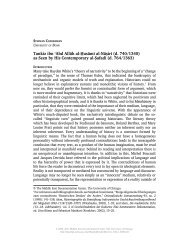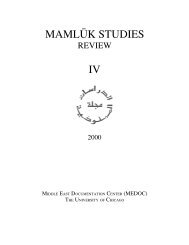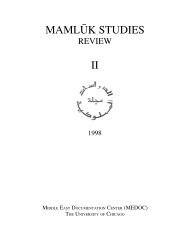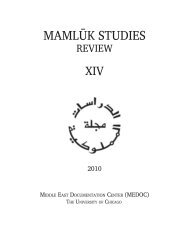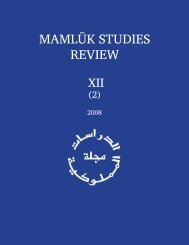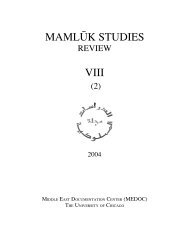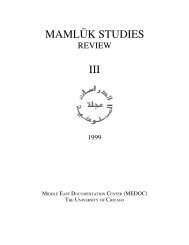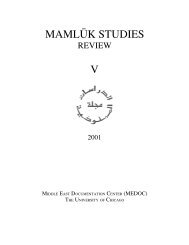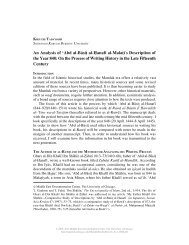Mamluk Studies Review Vol. VI (2002)
Mamluk Studies Review Vol. VI (2002)
Mamluk Studies Review Vol. VI (2002)
You also want an ePaper? Increase the reach of your titles
YUMPU automatically turns print PDFs into web optimized ePapers that Google loves.
4 W. W. Clifford, HAARMANN AND MAMLUK STUDIES<br />
Indeed, Haarmann's self-avowed goal was to detect the "patterning of . . .<br />
non-<strong>Mamluk</strong> cultural activities." 14 Whereas their <strong>Mamluk</strong> fathers had undergone a<br />
process of acculturation, these non-<strong>Mamluk</strong> offspring—the awla≠d al-na≠s—had<br />
had a kind of interculturative experience, wandering between the "two heterogeneous<br />
traditions" represented by the umara≠’ and ulama. Though not an anthropologist<br />
per se, Haarmann was nevertheless seeking to understand the cultural role of one<br />
of the chief carriers of social process in the "highly polarized" environment of late<br />
medieval Syro-Egypt. The awla≠d al-na≠s functioned primarily as interlocutors<br />
(Dolmetschern) between the bias of the Arabic-speaking ulama and the parochialism<br />
of the Turkish-speaking umara≠’, their placement at the social "fulcrum" symbolized<br />
by the heraldic emblem of the pen-box. All cultures, of course, undergo a certain<br />
degree of internal differentiation. But the awla≠d al-na≠s appear to have been<br />
something more than just culturally different. Haarmann at times gives an impression<br />
almost of alienation. For a group trapped eternally between the "barracks" (Kasernen)<br />
and the "mosque colleges" (Moscheehochschulen) this is not altogether surprising.<br />
Haarmann did not believe, however, that the awla≠d al-na≠s were "caught helplessly"<br />
between the two cultural camps. He felt that despite the informality of their social<br />
status, they at least "recognized their potential of surviving and indeed thriving as<br />
born . . . mediators." Still, their Mittlerstellung could not have been a comfortable<br />
cultural space to inhabit. 15<br />
Overshadowing their medial position were of course the ulama, who flatly<br />
"declared culture and science their own proper domain." Because of such absolutist<br />
claims to communicative competence the ulama had little incentive to understand<br />
the culturally "other" in <strong>Mamluk</strong> society. Even the appearance of Arabic-Qibjaq<br />
glossaries and Turkish grammars in early fourteenth-century Syro-Egypt, which<br />
Haarmann considered an important potential breakthrough in intercultural<br />
Kommunikation, did little to stimulate ulama interest in the literary sources of the<br />
Türkentum, which in addition to their (con)fusion of Faktum and Legende were<br />
viewed as entirely too pagan to be incorporated into the "hallowed genre of<br />
Islamic writing." Any possible "intercultural perspective" the ulama might have<br />
developed naturally "was stifled by various self-imposed dogmatic restrictions." 16<br />
These very same ulama, however, were not so shy about generating their own<br />
Haarmann, Cambridge <strong>Studies</strong> in Islamic Civilization (Cambridge, 1998): 55–84.<br />
14<br />
Haarmann, "Arabic in Speech,":82.<br />
15<br />
Ibid., 83; idem, "Väter und Söhne im Herrschaftssystem der <strong>Mamluk</strong>en," Berliner<br />
Wissenschaftliche Gesellschaft e.V-Jahrbuch (1995): 222.<br />
16<br />
Haarmann, "Alt¸un applea≠n und ¤ingiz applea≠n bei den ägyptischen <strong>Mamluk</strong>en," Der Islam 51 (1974):<br />
1–36; idem, "Arabic in Speech," 84, 85.<br />
© <strong>2002</strong>, 2012 Middle East Documentation Center, The University of Chicago.<br />
http://mamluk.uchicago.edu/<strong>Mamluk</strong><strong>Studies</strong><strong>Review</strong>_<strong>VI</strong>_<strong>2002</strong>.pdf



